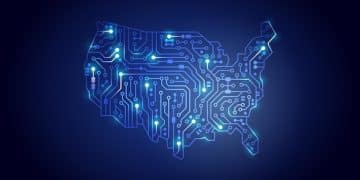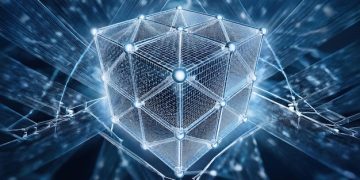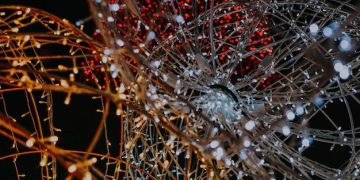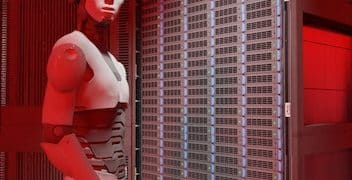Quantum Computing and US Cybersecurity by 2025: An Urgent Outlook

By 2025, quantum computing is poised to profoundly disrupt US cybersecurity, necessitating urgent strategic adaptations to counter new cryptographic threats while simultaneously leveraging quantum-safe solutions for enhanced national defense.
The landscape of cybersecurity is ever-evolving, and perhaps no technology holds as much promise—and peril—as quantum computing. As we approach 2025, the critical question arises: How will quantum computing impact US cybersecurity by 2025? This question is not merely academic; it is a pressing concern for national security, economic stability, and individual privacy.
The Looming Quantum Threat: Breaking Current Cryptography
The fundamental disruptive potential of quantum computing stems from its ability to perform certain computations vastly faster than classical computers. For cybersecurity, this primarily translates to an existential threat to many of the cryptographic algorithms that currently underpin global digital security. By 2025, while a fully fault-tolerant universal quantum computer capable of breaking widespread encryption may still be a few years away, the “harvest now, decrypt later” threat is very real. Adversaries could be collecting encrypted data today, intending to decrypt it once quantum capabilities mature.
The primary concern revolves around algorithms like Shor’s algorithm, which can efficiently factor large numbers and solve discrete logarithm problems. These are the mathematical foundations of public-key cryptography (PKC), including RSA and elliptic curve cryptography (ECC), which secure everything from web browsing (TLS/SSL) to digital signatures and secure government communications. If a powerful quantum computer becomes available, these widely used encryption standards could be rendered obsolete, creating an unprecedented vulnerability. The US government, along with critical infrastructure sectors, relies heavily on these cryptographic primitives for data protection and secure communication. The timeline to 2025 is particularly critical because the transition to new, quantum-resistant cryptosystems is complex and time-consuming. It involves not just developing new algorithms but also integrating them into existing hardware and software, a monumental undertaking that cannot be achieved overnight.
Vulnerability of Sensitive Data
The integrity and confidentiality of sensitive US data are directly at risk. This includes classified government information, military communications, financial transactions, healthcare records, and intellectual property. The exposure of such data could lead to widespread espionage, economic disruption, and compromise of national defense systems. The challenge by 2025 is to identify which data is most critical and what immediate steps can be taken to protect it from future quantum attacks.
- Government Secrets: Espionage by state-sponsored actors.
- Financial Systems: Risk of massive fraud and economic instability.
- Critical Infrastructure: Potential for disruption of power grids, water systems, and transportation.
- Intellectual Property: Loss of competitive edge for US industries.
The urgency is compounded by the fact that the quantum threat is not just theoretical; significant investment and progress are being made globally in quantum computing. While 2025 might not see the full deployment of a “crypto-cracking” quantum machine, the groundwork for a post-quantum cryptographic world must be firmly in place by then. The US government and private sector are beginning to take this seriously, but the pace of adoption and implementation needs to accelerate dramatically to mitigate the anticipated impacts.
Post-Quantum Cryptography (PQC): The Defensive Strategy
Recognizing the impending threat, significant research and development efforts are underway worldwide to develop and standardize Post-Quantum Cryptography (PQC) algorithms. These are cryptographic systems designed to be secure against both classical and quantum computers. The National Institute of Standards and Technology (NIST) in the US has been at the forefront of this effort, running a multi-year process to evaluate and standardize PQC algorithms. While the standardization isn’t fully complete by 2025, candidates are emerging, providing a roadmap for transition.
The transition to PQC is not a simple software update. It requires a comprehensive “crypto-agility” approach, where organizations can quickly and efficiently rotate out vulnerable algorithms and implement new ones. This involves inventorying all cryptographic assets, understanding dependencies, and preparing infrastructure for the shift. By 2025, several key PQC algorithms are expected to be either standardized or nearing finalization by NIST. This will signal the green light for wider adoption across government and industry. However, the sheer scale of deployment means that while the algorithms may exist, widespread implementation will still be a work in progress.
Challenges of PQC Implementation
Implementing PQC algorithms comes with its own set of challenges. These new algorithms are often larger in key size, slower in computation, and might require changes to existing hardware or protocols. Balancing security with performance and usability will be a critical task.
The US government, particularly agencies involved in cybersecurity and intelligence, is developing strategies for a phased migration. This typically involves identifying critical systems first, followed by a broader rollout. The private sector, especially those handling sensitive data like finance and healthcare, will need to follow suit, likely driven by regulatory requirements or market pressures. By 2025, we can expect to see early adopters among highly susceptible sectors testing and piloting PQC solutions.
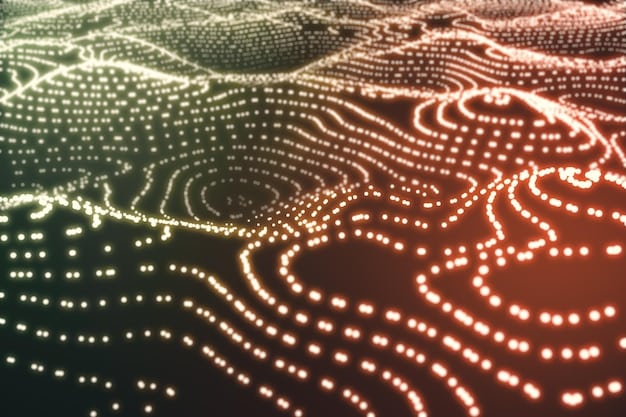
This defensive effort is paramount. An effective “quantum-safe” migration strategy will determine the US’s ability to maintain its digital sovereignty and protect its critical assets beyond 2025. The government’s role in guiding, funding, and mandating this transition will be crucial for its success.
Quantum Computing as an Offensive Tool
While the defensive implications of quantum computing are often highlighted, it’s equally important to consider its potential as an offensive weapon in the hands of state-sponsored actors. Beyond breaking existing encryption, quantum computing could accelerate advancements in artificial intelligence and machine learning, leading to more sophisticated cyberattack capabilities. By 2025, while direct quantum-powered cyberattacks on a large scale might still be nascent, the preparatory work for such capabilities could be well underway.
For instance, quantum-enhanced machine learning could rapidly analyze vast datasets to identify vulnerabilities in complex systems or develop more effective malware. Quantum annealing, a specific type of quantum computing, could be used for optimization problems like logistics and pathfinding, possibly in military strategies or supply chain disruption. A nation with a significant lead in quantum computing could potentially develop asymmetric advantages in cyber warfare, enabling them to penetrate defenses or disrupt systems in ways unimaginable with classical computers.
Sophisticated Attack Vectors
The potential for quantum-accelerated attacks goes beyond just decrypting data. It could involve:
- Enhanced Malware Development: Faster analysis for exploit discovery.
- Optimization of Attack Paths: Identifying the most efficient ways to breach complex systems.
- AI-Powered Reconnaissance: Quicker identification of network weaknesses.
The US intelligence and defense communities are undoubtedly exploring these offensive implications, not only to anticipate threats but also to potentially develop their own quantum-enhanced offensive capabilities. By 2025, the focus will be on understanding the theoretical limits and practical applications of these offensive quantum capabilities, influencing doctrines of cyber warfare and strategic deterrence. The dual-use nature of quantum technology, with both its defensive and offensive applications, necessitates a complex and balanced approach to its development and regulation.
Quantum-Resilient Infrastructure: Preparing for the Future
Preparing for the quantum era by 2025 means more than just implementing new algorithms. It involves building a truly quantum-resilient infrastructure. This encompasses a holistic approach to cybersecurity, integrating PQC into hardware, software, and network protocols, and developing a “crypto-agile” ecosystem. The concept of “quantum-safe” should become a fundamental design principle for new systems, rather than an afterthought.
Key to this is understanding the supply chain vulnerabilities. Many components and software libraries are sourced globally, and ensuring that these elements are PQC-compliant will be a massive undertaking. By 2025, the US government and leading technology companies will likely be developing guidelines and frameworks for quantum-safe hardware design and software development, but widespread compliance will still be years off.
Key Aspects of Quantum-Resilient Infrastructure
The transformation will touch every layer of the digital ecosystem:
* Hardware Root of Trust: Embedding PQC directly into chipsets.
* Secure Boot Processes: Ensuring software integrity even with quantum threats.
* Network Layer Security: Implementing quantum-safe VPNs and firewalls.
* Software Updates and Maintenance: A continuous process of updating cryptographic primitives.
Furthermore, developing a skilled workforce capable of understanding, implementing, and defending against quantum-level threats is critical. This involves significant investment in education, training, and recruitment of quantum-savvy cybersecurity professionals. By 2025, the demand for such expertise will be escalating rapidly, and the US will be racing to close the talent gap. Ensuring that the intellectual capital is available to manage this transition is just as important as the technological solutions themselves. The creation of a robust quantum-resilient infrastructure will be a long-term project, but foundational steps must be taken well before 2025 to avoid a catastrophic security gap.
International Cooperation and Geopolitical Landscape
The quantum threat is not confined to national borders; it’s a global challenge. International cooperation will be vital in developing shared standards for PQC, collaborating on research, and establishing norms for the responsible development and use of quantum technologies. Given the competitive nature of quantum development, geopolitical considerations will significantly influence how nations approach this new technological frontier. By 2025, discussions around quantum ethics, arms control, and shared defense postures will intensify.
The US, along with its allies, will likely push for multilateral agreements on the peaceful use of quantum computing and data-sharing protocols for quantum-related threats. However, the race for quantum supremacy among major global powers (US, China, EU) could also lead to increased secrecy and competition, potentially hindering global cybersecurity efforts. This tension between cooperation and competition will define the geopolitical landscape of quantum computing by 2025.
Harmonizing Global Standards
A fragmented approach to PQC standards could create interoperability issues and new vulnerabilities. International bodies and alliances will play a crucial role in harmonizing efforts, which includes:
- Shared Research Initiatives: Pooling resources for faster development.
- Standardization Bodies: Ensuring global compatibility of PQC algorithms.
- Threat Intelligence Sharing: Collaborating on understanding and mitigating new quantum-borne threats.
Quantum computing’s impact will extend beyond just technological disruptions to reshape international power dynamics, influencing economic competitiveness and national security. By 2025, the geopolitical implications of quantum computing will be front and center, requiring delicate diplomacy and strategic foresight from US leaders. The ability to navigate these complex international waters will be as critical as the technical advancements themselves in safeguarding US cybersecurity.
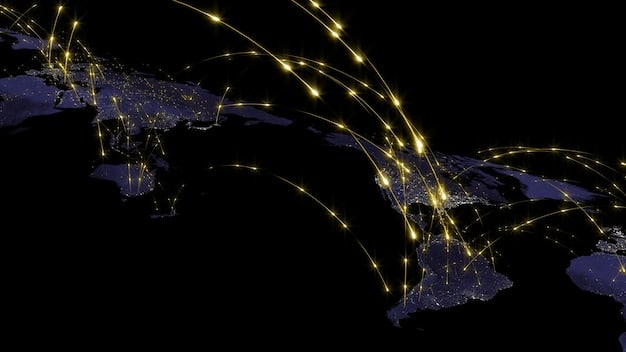
Economic Implications and Investment by 2025
The significant shifts brought about by quantum computing will have profound economic implications for the US by 2025. On one hand, there’s the enormous cost associated with upgrading existing cryptographic infrastructure across government and private sectors. This “quantum migration” will require substantial investment in new hardware, software, training, and expert consultation. Companies that fail to adapt could face severe financial penalties from data breaches or non-compliance with emerging quantum-safe regulations.
On the other hand, quantum computing presents a massive economic opportunity. The development of quantum technologies—hardware, software, services, and PQC solutions—will create new industries and jobs. The US is vying for global leadership in this domain, with significant government funding and private venture capital flowing into quantum research and startups. By 2025, we can expect to see further consolidation and maturation of the quantum industry, with early commercial applications beginning to emerge in specialized fields, potentially including advanced cybersecurity tools.
Sector-Specific Impacts and Opportunities
Various sectors will experience unique challenges and opportunities:
* Financial Services: Massive investment in quantum-safe transactions.
* Healthcare: Protection of sensitive patient data from quantum decryption.
* Defense and Government: Prioritized upgrades for national security.
* Technology Sector: Innovation leading to new products and services.
The economic incentive for companies to become quantum-ready will grow stronger closer to 2025, driven by market demand and regulatory pressure. Businesses that proactively invest in PQC and quantum-safe practices will gain a competitive advantage, demonstrating their commitment to data security and future-proofing their operations. The US government’s role in stimulating this investment through grants, tax incentives, and clear regulatory guidance will be crucial in accelerating the quantum economic transition. Ultimately, embracing quantum computing also means understanding and capitalizing on its economic potential, not just mitigating its risks.
The Human Element: Workforce and Awareness
Beyond the technological and economic challenges, the human element remains paramount in addressing how quantum computing will impact US cybersecurity by 2025. There is an urgent need to cultivate a workforce with the requisite skills to understand, implement, and manage quantum-safe systems. This includes not just quantum physicists and computer scientists, but also cybersecurity professionals, network engineers, and policymakers who grasp the nuances of this transformative technology. By 2025, the gap between the demand for quantum-savvy professionals and the available talent pool is projected to be significant, posing a hurdle to effective quantum migration.
Educational institutions, government training programs, and private sector initiatives must accelerate efforts to develop comprehensive curricula and certification programs focused on quantum computing and PQC. Awareness campaigns are also critical, not only within technical communities but also among senior leadership in government and industry. Many decision-makers still lack a comprehensive understanding of the quantum threat’s urgency and magnitude. By 2025, a clearer, more widespread understanding of “crypto-agily” and the need for immediate action will become essential for effective national cybersecurity.
Addressing the Skill Gap
To bridge the talent gap, several strategies are being pursued:
- University Programs: Expanding quantum computing and PQC courses.
- Professional Training: Developing workshops and certifications for existing cybersecurity professionals.
- Recruitment Initiatives: Attracting talent from diverse backgrounds into quantum-related fields.
The human element also extends to public awareness. While a full understanding of quantum mechanics isn’t necessary, a basic grasp of why our current encryption methods are at risk and what steps are being taken to protect data is vital for public trust and cooperation. By 2025, the narrative around quantum computing should shift from abstract scientific curiosity to a tangible, strategic imperative for national security and economic resilience. Investing in people and fostering widespread awareness is as critical as investing in the technology itself to ensure the US is prepared for the quantum future.
| Key Area | Impact by 2025 |
|---|---|
| Threat to Crypto 💥 | Current public-key encryption vulnerable; “harvest now, decrypt later” is a major concern. |
| PQC Adoption 🛡️ | NIST’s PQC standards nearing finalization; early adoption and pilot programs underway. |
| Offensive Capabilities ⚔️ | Quantum-enhanced AI/ML could create more sophisticated cyberattack vectors. |
| Workforce Readiness 🧑💻 | Growing demand for quantum-savvy cybersecurity professionals; education gap needs addressing. |
Frequently Asked Questions
▼
While a universal quantum computer capable of breaking all widely used encryption is unlikely to be fully operational by 2025, the theoretical threat exists. Critical public-key cryptography like RSA and ECC are at risk. Data harvested before 2025 could be decrypted later, necessitating immediate action on post-quantum cryptography.
▼
PQC refers to cryptographic algorithms designed to resist attacks from both classical and quantum computers. NIST is actively standardizing these algorithms. By 2025, several PQC candidates will be finalized, providing practical solutions for organizations to begin transitioning their systems to quantum safety.
▼
Critical infrastructure sectors like energy, finance, and transportation rely heavily on public-key cryptography for secure communications and data integrity. If current encryption is broken, these sectors face significant disruption, potential espionage, and system compromise. Proactive quantum-safe migration is essential to protect these vital systems.
▼
The US government, led by NIST, is spearheading PQC standardization efforts and developing agency-specific transition plans. It also funds quantum research, invests in workforce development, and fosters international cooperation to address the quantum threat while exploring potential offensive capabilities.
▼
Yes, while quantum migration is costly, it also creates new economic opportunities. The development, implementation, and maintenance of quantum-safe hardware, software, and services will foster new industries, create jobs, and potentially lead to highly advanced cybersecurity tools, fueling innovation and competitive advantage.
Conclusion
By 2025, quantum computing will not just be a theoretical concept but a tangible force shaping US cybersecurity. The countdown to a post-quantum world has already begun, driven by the dual threat of quantum attacks on current encryption and the offensive capabilities quantum computing may unlock. The US must urgently accelerate its transition to post-quantum cryptography, build quantum-resilient infrastructure, and strategically navigate the geopolitical landscape. Investing in research, fostering international cooperation, and developing a skilled workforce are not merely options but imperatives. The resilience of US cybersecurity in 2025 will hinge on the proactive, comprehensive, and collaborative efforts undertaken today to embrace the quantum age responsibly and securely.
